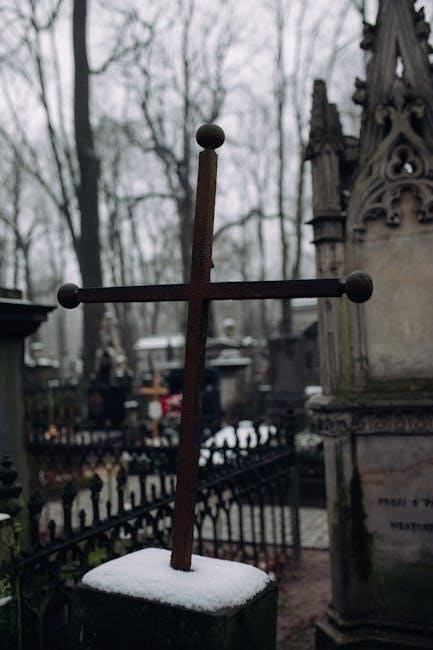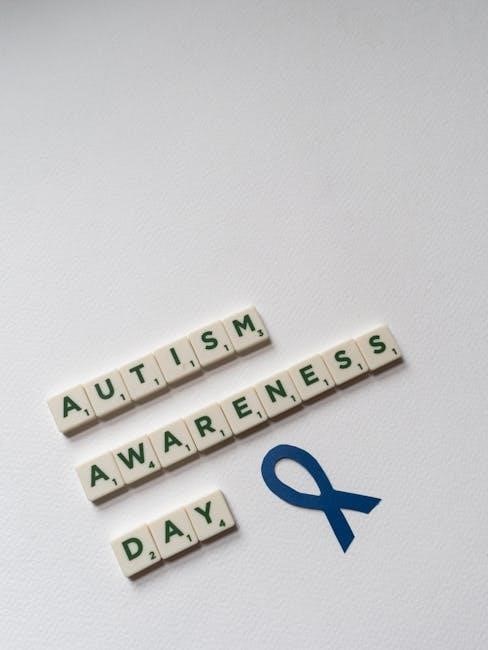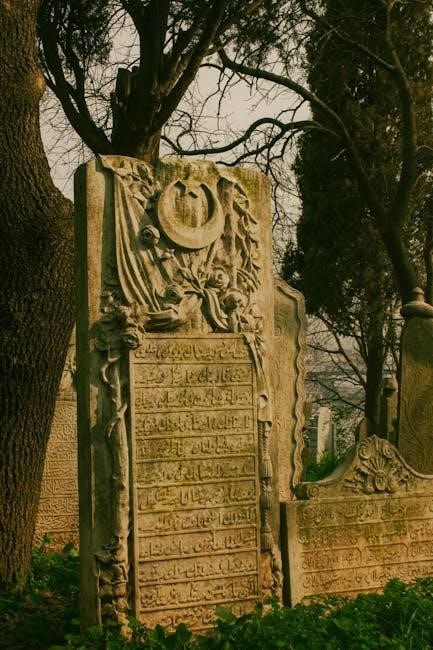
understanding cemetery symbols pdf
Cemetery symbols serve as a visual language, conveying emotions, beliefs, and stories about the deceased. They offer comfort and insight, bridging life and death with profound meaning.
Historical Background of Cemetery Symbols
Cemetery symbols trace back to ancient cultures, evolving over centuries. Early Christians used anchors and crosses, while Victorian-era cemeteries popularized intricate carvings reflecting sorrow and eternal hope.
Evolution of Graveyard Art and Symbolism
Graveyard art and symbolism have evolved significantly over centuries, reflecting changing cultural, religious, and societal values. Early symbols, such as anchors and crosses, carried simple yet profound meanings. The Victorian era brought intricate carvings, emphasizing mourning and eternal life. Nature-inspired motifs like trees and flowers became popular, symbolizing eternity and the cycle of life. This evolution mirrors broader shifts in how societies view death, memory, and the afterlife, creating a rich, layered language of remembrance in cemeteries worldwide.
Cultural Influences on Cemetery Symbols
Cultural influences deeply shape cemetery symbols, reflecting diverse traditions and beliefs. For instance, European cemeteries often feature crosses and angels, mirroring Christian faith, while Asian sites incorporate symbols like lotus flowers, representing spiritual growth. Indigenous cultures may use tribal motifs to honor ancestors. These symbols not only express individual identities but also collectively preserve cultural heritage, offering a visual narrative of shared history and values across generations.

Religious Symbols in Cemeteries
Religious symbols in cemeteries provide spiritual comfort and reflect faith. Crosses, angels, and anchors are common, signifying hope, guidance, and eternal life, connecting mourners to divine assurance.
Christian Symbols: Crosses, Angels, and Anchors
Christian symbols in cemeteries often reflect faith, hope, and eternal life. The cross, a central emblem, represents the resurrection and divine sacrifice. Angels, depicted as gentle guides, symbolize protection and heavenly escort. Anchors, rooted in early Christian imagery, embody hope and steadfastness, often linking the deceased to a life at sea or a steadfast faith. These symbols serve as comforting reminders of spiritual beliefs, offering solace to mourners while celebrating the deceased’s eternal journey.
Other Religious Symbols: Stars, Crescents, and More
Beyond Christian imagery, cemeteries feature symbols from diverse faiths. The star and crescent, common in Islamic and Jewish traditions, signify divine guidance and faith. The swastika, a Buddhist emblem, represents balance and righteousness. In pagan contexts, the pentagram embodies protection and harmony. These symbols, often intertwined with cultural heritage, reflect the deceased’s spiritual identity. They provide a visual narrative of beliefs, offering comfort and connection to mourners while honoring the individual’s faith journey and legacy.
The Meaning of Angels and Winged Figures
Angels and winged figures are poignant symbols in cemeteries, representing divine protection, guidance, and the soul’s journey to heaven. Often depicted as guardians, they embody hope and comfort for mourners. Winged symbols, such as doves, signify peace and the release of the spirit, while soul effigies with wings represent immortality and the transition to the afterlife. These figures serve as a bridge between the earthly and celestial realms, offering solace and a visual reminder of eternal life and divine care.

Secular Symbols in Cemeteries
Secular symbols in cemeteries honor the deceased through non-religious imagery, reflecting personal qualities, achievements, or circumstances. They often represent time, knowledge, or mourning, offering universal themes of remembrance.
Hourglasses, Clocks, and the Passage of Time
Hourglasses and clocks in cemeteries symbolize the fleeting nature of life and the inevitability of death. These symbols remind us that time is precious and irreversible. Hourglasses often feature wings, representing the soul’s journey to the afterlife, while clocks may be stopped at the exact time of death, freezing a moment forever. Together, they underscore mortality and the transition from earthly existence to eternal rest, serving as poignant reminders of life’s brevity and the passage of time.
Keys and Their Symbolic Meaning
Keys are common cemetery symbols, often representing knowledge, wisdom, or spiritual awakening. They may signify the deceased’s role as a guide or their ability to unlock heavenly gates. In some contexts, keys symbolize eternal life, offering hope of divine access. Their presence on tombstones serves as a reminder of the mysteries beyond life, emphasizing the transition to the afterlife and the enduring legacy of the deceased in the hearts of loved ones.
Broken Columns and Pillars: Lives Cut Short
Broken columns and pillars in cemeteries symbolize lives cut short, representing unfinished journeys or potential unfulfilled. They often commemorate young individuals or those who died unexpectedly, serving as poignant reminders of mortality. These symbols evoke a sense of loss and longing, while also celebrating the enduring memory of the deceased. Their presence offers comfort to grieving families, acknowledging the abrupt end of a life while honoring its significance.

Nature-Inspired Symbols
Nature-inspired symbols in cemeteries represent life, eternity, and harmony. Elements like vines, flowers, trees, and animals signify growth, renewal, and the connection between Earth and the afterlife.
Trees and Their Symbolism: Life and Eternity
Trees in cemeteries symbolize life, strength, and eternity. Evergreens signify eternal life, while oak trees represent longevity and wisdom. Broken branches or fallen trees may indicate a life cut short, while budding trees symbolize renewal and hope. Roots often symbolize family ties and heritage. Trees are a powerful metaphor for the cycle of life, offering comfort and a connection to nature’s enduring presence.
Flowers and Their Meanings: Roses, Lilies, and More
Flowers in cemeteries carry deep symbolic meanings. Roses often represent love and completion of life, while lilies symbolize purity, innocence, and resurrection. Daisies may denote innocence or childhood, and lavender signifies devotion. Sunflowers can represent loyalty and adoration. Wilted or broken flowers may indicate a life cut short. These blooms serve as a poignant way to express emotions and honor the deceased, offering solace and connection to their memory.
Animals in Cemetery Art: Lambs, Doves, and Others
Animals in cemetery art often symbolize virtues or traits of the deceased. Lambs represent purity, innocence, and gentleness, frequently used for children’s graves. Doves signify peace, love, and the soul’s ascent to heaven. Birds may symbolize the flight of the soul, while deer represent humility and grace. Dogs, embodying loyalty, are sometimes depicted. These symbols offer comfort, reflecting the deceased’s character and providing solace to mourners. They add a touching, personal element to grave markers, connecting visitors to the life remembered.

Common Cemetery Motifs
Cemetery motifs reflect themes of life, death, and the afterlife. Arches signify entry to eternity, while urns and drapery symbolize mourning. Obelisks and columns honor enduring memory.
Arches and Gates: Passage to the Afterlife
Arches and gates in cemeteries symbolize the transition from earthly life to the afterlife. These motifs often represent triumph and victory, serving as a gateway to eternal peace. They are frequently adorned with intricate carvings and inscriptions, emphasizing hope and eternal rest. In many cultures, arches signify strength and endurance, while gates may denote protection and guidance. Together, they create a powerful visual metaphor for the soul’s journey beyond mortality, offering solace to those who mourn.
Obelisks and Their Significance
Obelisks are towering, needle-like structures commonly found in cemeteries, symbolizing eternal life and heavenly aspirations. Originating from ancient Egypt, they represent enduring memory and divine connection. Often inscribed with names and dates, obelisks honor the deceased while reaching toward the sky, signifying a bridge between earth and heaven. Their simplicity and grandeur evoke timeless remembrance, making them a poignant choice for commemorating loved ones and celebrating their eternal legacy.
Urns and Drapery: Mourning and Memory
Urns adorned with drapery are poignant cemetery symbols representing mourning and remembrance. The urn itself signifies the soul’s journey to the afterlife, while drapery embodies sorrow and loss. Often, these symbols are paired with flowers or crosses, enhancing their emotional depth. Drapery may also drape over urns, monuments, or sarcophagi, symbolizing veiled grief and the transient nature of life. Together, they serve as a visual tribute to the deceased, offering solace to the living through their enduring presence in cemetery art and design.

Cemetery Statuary and Sculptures
Cemetery statuary and sculptures, such as saints and angels, serve as protective figures, guiding souls to the afterlife. These symbolic pieces offer comfort to mourners, embodying eternal vigilance and grace.
Saints and Their Representations
Saints in cemetery art are often depicted as spiritual guardians, watching over the deceased and guiding souls to the afterlife. Figures like Saint Peter, holding keys to heaven, symbolize entry into the divine realm. Saint Michael, as a warrior, represents protection against evil. The Virgin Mary, embodying maternal care, is frequently shown to signify compassion and eternal life. These sculptures serve as comforting reminders of faith and divine presence, helping mourners connect with their loved ones and find solace in their beliefs.
Angels and Other Protective Figures
Angels are common in cemetery art, symbolizing protection, guidance, and divine care for the deceased. Often depicted with wings, they embody celestial guardianship and the journey to the afterlife. Some angels carry trumpets, signaling the resurrection, while others cradle children, representing innocence. Protective figures like cherubs or guardian angels convey reassurance of eternal safety. These sculptures provide comfort to mourners, reinforcing beliefs in divine watchfulness and the soul’s safe passage to heaven, while also celebrating the life and memory of the departed with serene and hopeful imagery.

Symbolic Objects in Cemeteries
Symbolic objects in cemeteries, like urns, keys, and books, carry deep meanings, such as mourning, knowledge, and heavenly entry, offering comfort and remembrance to the living.
Coin and Seashell Symbolism
Coin and seashell symbolism in cemeteries holds deep meaning. Coins often represent a farewell gesture or payment for the afterlife journey, while seashells symbolize resurrection and protection. Placed on graves, they serve as silent messengers, honoring loved ones with timeless significance. These objects bridge the living and the deceased, offering comfort through their enduring symbolic power.
Books, Scrolls, and Knowledge
Books and scrolls in cemeteries symbolize wisdom, faith, and the pursuit of knowledge. Open books often represent a life well-lived or devotion to scripture, while scrolls may signify divine wisdom or the Book of Life. These symbols honor individuals who valued learning or spiritual growth, serving as enduring tributes to their intellectual or theological contributions. They remind visitors of the importance of knowledge and its lasting impact beyond mortality.

Regional Variations in Cemetery Symbols
Cemetery symbols vary significantly across regions, reflecting local traditions and cultural influences. These differences highlight unique customs, religious practices, and historical contexts, offering insights into diverse belief systems worldwide.
European vs. American Cemetery Symbols
European cemetery symbols often reflect deeper historical and religious ties, with intricate carvings and classical motifs. In contrast, American symbols tend to blend cultural influences, showcasing a more diverse and personalized approach. European grave markers frequently feature crosses, angels, and traditional Christian imagery, while American cemeteries may incorporate a wider range of secular and religious symbols. These differences highlight the unique historical and cultural contexts shaping cemetery art across the Atlantic.
Symbolism in Asian and Middle Eastern Cemeteries
Asian and Middle Eastern cemeteries often blend religious and cultural symbols, reflecting deep spiritual beliefs. In many Asian traditions, symbols like lotus flowers and bamboo represent immortality and resilience. Middle Eastern grave markers frequently feature intricate geometric patterns and calligraphy, emphasizing divine connection. These symbols often honor ancestors and the afterlife, with designs varying by region and faith, showcasing a rich tapestry of meaning and tradition in mourning and remembrance.

Symbolism of Life and Death
Cemetery symbols often juxtapose life and death, using imagery like trees for eternity and skulls for mortality, helping mourners grasp the cycle of existence.
Skulls and Mortality
Skulls and crossbones are powerful symbols of death and mortality, often found in older cemeteries. They remind mourners of the inevitability of death and the transience of life. In some cultures, skulls represent the soul’s journey to the afterlife, while in others, they serve as stark reminders of human frailty. Paired with symbols like hourglasses, they emphasize the passage of time and the irreversible nature of death. These motifs help confront grief, urging the living to reflect on their own mortality and the legacy they will leave behind.
Soul Effigies and the Afterlife
Soul effigies, often depicted as winged figures or human forms, symbolize the journey of the soul to the afterlife. These carvings, found on gravestones, represent the deceased’s eternal essence. Wings signify ascension to heaven, while serene expressions convey peace and divine acceptance. Soul effigies comfort mourners by embodying the belief in an enduring spirit. They serve as a visual reminder of the soul’s immortality, transcending physical death and connecting the living to the spiritual realm through art and symbolism;

A Guide to Understanding Cemetery Symbols
This guide serves as a comprehensive tool for understanding cemetery symbols, aiding in interpreting meanings and exploring graveyards with deeper insight for both enthusiasts and researchers alike.
How to Identify and Interpret Symbols
To identify and interpret cemetery symbols, start by examining the context and design of the imagery. Research the historical and cultural background of the symbol, as meanings often vary. Consider the religious or secular cues, such as crosses for Christianity or anchors for hope. Use guides or field manuals to cross-reference symbols like hourglasses, keys, or angels. Pay attention to details like broken columns or upside-down torches, which may signify a life cut short. By combining observation with research, you can unlock the profound stories behind these silent messengers.
Using This Guide for Cemetery Exploration
This guide is a valuable tool for exploring cemeteries, helping you decipher the hidden meanings behind symbols and carvings. Start by familiarizing yourself with common motifs like anchors, angels, and hourglasses. As you walk through a cemetery, reference the guide to identify symbols and understand their significance. Use the glossary to uncover stories about the deceased and their lives. This guide enhances your experience, transforming a cemetery visit into a journey of discovery and connection with the past.